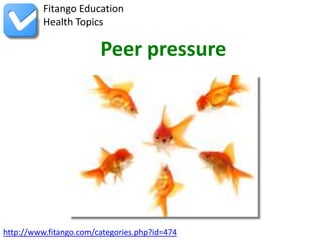Peer pressure
•Download as PPTX, PDF•
5 likes•4,446 views
Children often seek a sense of belonging at school and will engage in certain behaviors to fit in among their peers (someone in their age group). Even in preschool they are becoming concerned with what their friends think and do. Children want to be well liked and included in a group, which makes them susceptible to peer pressure (influence that members of the same age group can have over each other). Peer pressure has been shown to affect children as early as preschool age and becomes an even greater risk as they transition into middle and high school.
Report
Share
Report
Share

Recommended
Recommended
More Related Content
What's hot
What's hot (20)
Positive Approaches to managing Behaviour in the Early years

Positive Approaches to managing Behaviour in the Early years
Viewers also liked
Viewers also liked (18)
DIGITALLY MODIFIED CHILDREN- THE NEW THREAT TO THE HUMANITY

DIGITALLY MODIFIED CHILDREN- THE NEW THREAT TO THE HUMANITY
The Arts and Humanities in a Digital Age: Disruptions and Continuities

The Arts and Humanities in a Digital Age: Disruptions and Continuities
Humanities in the age of digital technology (English) V5xx

Humanities in the age of digital technology (English) V5xx
20 Tips for Parents for Succesful Parent-Teacher Conferences in the U.S

20 Tips for Parents for Succesful Parent-Teacher Conferences in the U.S
Similar to Peer pressure
Similar to Peer pressure (20)
Child and adolescence(socio emotional development)

Child and adolescence(socio emotional development)
TOP TEN TIPS FOR FOSTERING CHILDREN'S RESILIENCE AFTER DIVORCE

TOP TEN TIPS FOR FOSTERING CHILDREN'S RESILIENCE AFTER DIVORCE
CHFD215 LESSON 7Social Understanding, Peers, Media, and Sc.docx

CHFD215 LESSON 7Social Understanding, Peers, Media, and Sc.docx
Protective Factors that Prevent Child Abuse & Neglect

Protective Factors that Prevent Child Abuse & Neglect
More from fitango
More from fitango (20)
Peer pressure
- 1. Fitango Education Health Topics Peer pressure http://www.fitango.com/categories.php?id=474
- 2. Overview Children often seek a sense of belonging at school and will engage in certain behaviors to fit in among their peers (someone in their age group). Even in preschool they are becoming concerned with what their friends think and do. 1
- 3. Overview Children want to be well liked and included in a group, which makes them susceptible to peer pressure (influence that members of the same age group can have over each other). Peer pressure has been shown to affect children as early as preschool age and becomes an even greater risk as they transition into middle and high school. 2
- 4. Positive and negative Peer pressure can impact children both positively and negatively - positive peer pressure may influence a child to engage in healthy behaviors while negative peer pressure can eventually lead to risky behaviors such as substance use. Every child is susceptible to various forms of peer pressure. Research indicates that parents and caregivers that engage in an authoritative parenting style - a child-centered approach often referred to as balanced parenting where monitoring and support are above av 3
- 5. Positive and negative Peer relationships (relationships with children their own age) are important in a child’s life as they form the basis of friendships and, help develop certain social skills, such as cooperation, negotiation and conflict resolution. The importance of choosing and forming these relationships is vital even during the preschool years as peers have been shown to have strong influences on risky behaviors later on in life. 4
- 6. Ways of exerting pressure Peer pressure in young children usually revolves around what toys to play with or what games to play. Children also exert pressure through teasing, name-calling, withholding friendship, and by threatening exclusion from play. They may also dare each other to leap from high places or squeeze into tight spaces, inviting bodily harm. Later on, as your child transitions into middle school, that pressure becomes more intense as kids try to conform or “be cool” in order to be included in the group 5
- 7. Preparing your child Start building the foundation to help children deal with those who might try to pressure them into doing something risky. Once children approach adolescence, they will encounter greater negative peer pressure to engage in very risky behaviors, such as smoking, drinking, and sexual activity and will need the confidence to stand up for themselves. 6
- 8. Preparing your child -- Say “NO.” You set limits for your child; you should practice parental monitoring by saying “no” to something that is against your rules or could impact them negatively. They, too, can learn to say “no,” sometimes over and over again to resist peer pressure. 7
- 9. Preparing your child -- Then, teach them how they could use some of these tactics to say “no” to their peers who may try to influence them to do something that is against the rules. They could: change the subject; suggest another activity; say, “I can’t, I’m not allowed”; ignore the other child; or, just walk away—all of these are useful refusal skills. 8
- 10. Preparing your child -- Choose good friends. Know who your child’s friends are and remind him/her that a good friend would not try to force him/her to do something he/she should not do. 9
- 11. Preparing your child -- Make good decisions. It is not too early to help children think carefully about the outcome and consequences of an act before they do it. Think aloud and let your child listen to your decision- making processes, as you weigh options and potential outcomes. 10
- 12. Preparing your child -- Value themselves. Praise your children for something they do well, encourage them in positive, healthy pursuits, and surround them with people who value them. These actions increase their self-confidence and make it difficult for someone else’s opinion of them to be more important than their own. 11